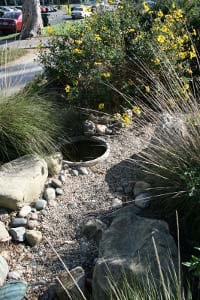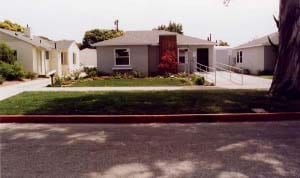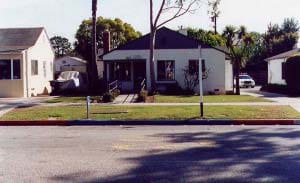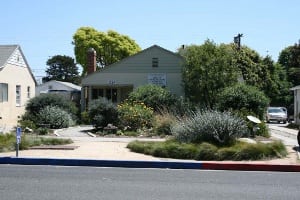Amid a sea of talk about the benefits of sustainable landscaping, there is precious little information to prove that it actually makes sense, environmentally or economically. Landscape professionals have long operated on a hunch that sustainable landscapes save water, reduce labor, minimize fossil fuel use, and offer other benefits over conventional turf-and-flowerbed landscapes, but without hard data it’s difficult to make a case to skeptics. That’s where the Garden/Garden Project comes in.
The conventional landscape consists of 70 percent turf, beds filled with thirsty plants, no mulch, an overhead sprinkler system, and a time-based “dumb” controller. The sustainable landscape is made up of native plants, water conserving mulch, a water-harvesting system consisting of a dry streambed and an infiltration chamber, pervious paving, a drip irrigation system, and a satellite-driven smart irrigation controller.
The conventional site looks pretty much like most of the front yards in the neighborhood and doesn’t draw a second glance. The sustainable site is beautiful and eye-catching, flowery, artistic, and engaging. Unlike the barren traditional landscape, the sustainable one also provides habitat for native birds and insects. But that’s really not the point of the two gardens. They were created specifically to quantify the cost and labor differences between the two approaches, and to confirm once and for all whether sustainable landscaping makes financial sense.
The sustainable garden cost $22,000 ($11.06 per square foot) and the traditional one was $14,000 ($7.50 per square foot). But the payback time was very short and the additional $8,000 was fully recovered in less than two years, mostly from savings in maintenance. Additionally, local cash rebates are available for sustainable landscaping projects, and at the time the Garden/Garden Project was built a homeowner would have received up to $20,000 for installing a similar landscape. Currently rebates would be up to $5,000, which is still a considerable savings and a great incentive to install a sustainable landscape.
Russell Ackerman, CLIA, Water Resources Specialist with the City of Santa Monica reports that the project has been a complete success. He says, “Planting a sustainable landscape improves the look of your property, the quality of your neighborhood, the health of the planet…and now, even your bottom line. The numbers speak for themselves. Our data proves it.”
The Take-away
The take-away for landscape professionals is that doing projects sustainably offers clients an excellent return on their investment, the landscapes are much easier to live with, and of course they are better for the environment in so many ways. Getting clients to accept sustainable landscapes no longer has to depend solely on their environmental benefits. That means that sustainable landscaping isn’t just for your progressive clients; it will appeal to any property owner who is sensitive to the bottom line. And that can make all the difference if you’re trying to please a wide range of clients and also stay true to your commitment to the environment.
The Garden/Garden Project is located at 1724 & 1718 Pearl St., Santa Monica. For more information, visit http://www.smgov.net/Departments/OSE/Categories/Landscape/Garden-Garden.aspx.
About the Author
Owen Dell, ASLA, is a Santa Barbara-based landscape architect, educator, and author of “Sustainable Landscaping for Dummies” and “How to Start a Home-Based Landscaping Business.” Owen is one of the leading proponents of sustainable landscaping and a long-time member of the Ecological Landscape Alliance. Learn more about Owen at www.owendell.com.






